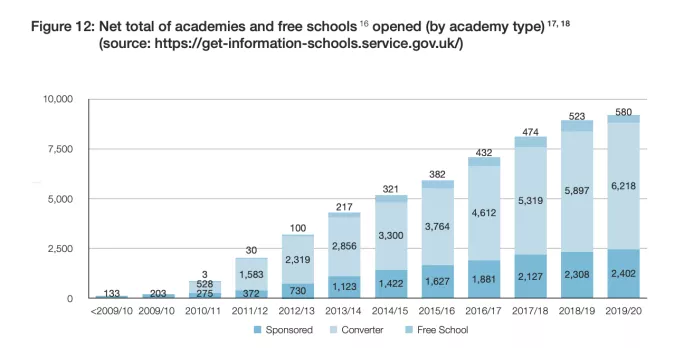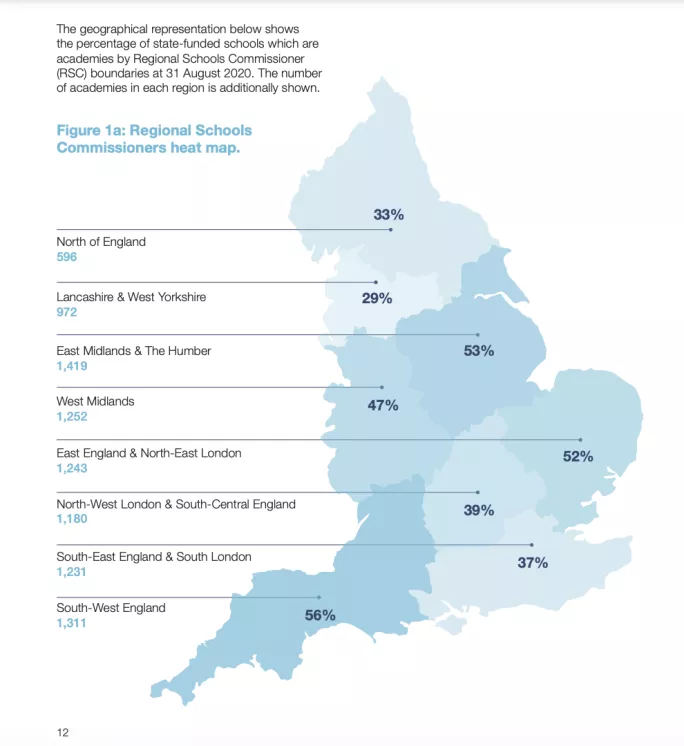Academy conversions drop by half

The number of schools converting to academies fell by almost 50 per cent last year, recent accounts show, with the government blaming the impact of Covid-19.
A new report published by the Department for Education reveals that 474 schools converted to academy status in 2019-20, compared with 908 in 2018-19.
It also shows that the rate at which schools have been converting to academies has been slowing down over a four-year period.
Background: Williamson wants ‘far more schools’ moving into MATs
DfE: Most maintained schools not planning to academise
Zahawi: Government won’t set arbitrary academisation target
There was a 5 per cent increase in the number of academies between July 2019 and July 2020.
But the academisation rate has been dropping year on year since 2015-16, tables show.

In July 2019 there had been a 10 per cent increase in the number of academies compared with a year earlier.
In July 2018 the number of academies was up 14 per cent on the year before and in 2017 it was 19 per cent higher than the previous year.
The DfE report says that trusts, schools and the department had been focusing on the safe reopening of schools during the start of the pandemic.
Regional variation in schools converting to academies
The Academy Schools Sector in England Consolidated Annual Report and Accounts, published by the DfE, also highlights a regional variation in the proportion of academies in different parts of the country.
It shows that 42 local authorities (LAs) had at least 50 per cent of their state-funded primary provision operating as academies as of July 2020.
At either end of the spectrum, four LAs had less than 5 per cent primary academy provision and three had more than 90 per cent primary academy provision last year.
Regarding secondaries in England, the DfE says that in 2020 four out of five state-funded schools operated as an academy and all LAs had at least 10 per cent of their secondary provision as academies.
The accounts show that there were 141 LAs with state-funded alternative provision (AP) in 2020, of which 61 LAs had no academy AP.
The report also shows the number of academies in each of the regional schools commissioner (RSC) regions of England. The DfE created these regions to have local oversight of the academies programme.
The South West Region had the highest proportion of academies at 56 per cent.
In contrast, in Lancashire and West Yorkshire just 29 per cent of state schools were academies.
DfE map showing academies by RSC region

Dr Mary Bousted, joint general secretary of the NEU teaching union, said the fall in academy converters “has little to do with Covid”.
“The academy project has for much of its history been driven by government coercion and schools viewed as low-hanging fruit being forced into academisation,” she said,
“The reason for the project’s loss of momentum has little to do with Covid. It has been around long enough for people to see through the government’s hype, and to know that academy status is not a magic solution. Indeed, far too often it can have the reverse effect on a school’s fortunes.”
Paul Whiteman, general secretary of school leaders’ union the NAHT, said it was unhelpful to focus on school structures while school leaders are dealing with the pandemic.
“Schools of all different types have stepped up during the pandemic to keep education going for pupils, and even to feed and care for them when times got really rough,” he said, “If the last two years have proved anything, it’s that the name and structure of a school is not nearly as important as the teachers and leaders in it.
“For some schools, who feel academisation is right for them, this delay to their plans will have been a frustration. For others, the past year will have been a welcome reprieve from the unhelpful threat of forced academisation.”
Former education secretary Gavin Williamson said in March this year that the government was actively looking for a way to get more schools into multi-academy trusts.
However, a survey of school leaders published in November by the DfE showed that the majority of maintained school leaders did not want to convert their schools into academies over concerns around losing their autonomy.
The DfE found that the vast majority of “non-converters” (94 per cent of primary schools and 87 per cent of secondary schools) felt that there would be “some negatives associated with converting to academy status”.
Education secretary Nadhim Zahawi said in October that the government was not setting a deadline for schools to convert to academy status but added that he believed there were benefits in schools doing so.
Addressing the NAHT school leaders’ union conference in London, he said: “I do believe that schools do benefit from being part of a multi-academy trust.
“We’re not going to set an arbitrary deadline to achieve a wholesale structural change. But I think the strength of the trust structure, the evidence is pretty clear, I think, once again during the pandemic, of how well they were able to respond.”
You need a Tes subscription to read this article
Subscribe now to read this article and get other subscriber-only content:
- Unlimited access to all Tes magazine content
- Exclusive subscriber-only stories
- Award-winning email newsletters
Already a subscriber? Log in
You need a subscription to read this article
Subscribe now to read this article and get other subscriber-only content, including:
- Unlimited access to all Tes magazine content
- Exclusive subscriber-only stories
- Award-winning email newsletters
topics in this article



